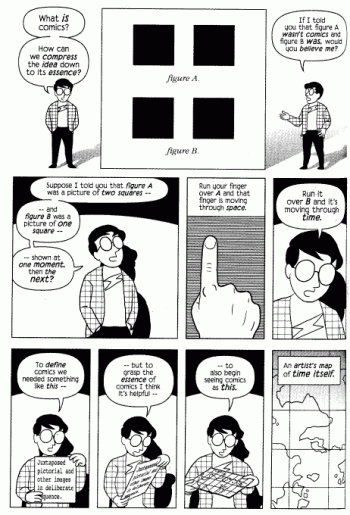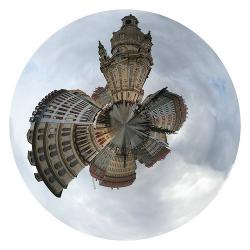Serendip is an independent site partnering with faculty at multiple colleges and universities around the world. Happy exploring!
Notes of Day 19, April 1st 2010: Mapping Time Through Space

We began class with a look at Scott McCloud notion of comics "mapping" time through use of space on the medium (whether it be a computer screen or a print version).

However, Scott McCloud's description of images and words did not accurately portray our responses to Neil Gaiman's A Game of You.
Speculations are why reading a graphic novel:
We are so trained (programmed?) to decode text, that it is far more natural and instantaneous than pictures.
Yet, a speechless commercial would still portray the product's message to us.
An image by itself is ok, but coupled with words, it is confusing, too busy.
It's different from the Alice in Wonderland illustrations. With A Game of You, it's like trying to do two things at once.
These might just pertain to A Game of You and not so much other comics. Still, reading a graphic narrative might be a matter of experience.
There is a stigma against books with pictures. They are seen as fit for only small children. Adult books have words. Literary critics seem to have trouble with graphic narratives as legitimate forms of literature.
A topic for thought: Why do we prefer the written over the drawn? Is it merely tradition? Because we're "used" to it and any kind of change over this is frightening?
We came to a consensus that there are something like two worlds of pictures and words and two levels each to Gaiman's graphic novel. There are the instantaneous recognition of the pictures and words. Then there are the deeper levels of complex understanding from the drawn and the written.
We moved on to the discussion of thought bubbles. Why are they not dignified? What is the significance of them? Third person omniscient narration seems old-fashioned, coming from a time in which we believed the God's-Eye-View was obtainable. Now we read partial narration, or third-person limited narrative. Is this an approach attempting to imitate reality?
We looked specifically at the beginning page (the one right after the plastic cover and before the introduction and title page) and its contents. Why are these quotes here? Why is this picture here and blurred and obscure? What is that "A" doing there? What do the text and pictures mean for the rest of the novel?
We examined p.130 and how the ambiguity of identity from the text is reinforced and even created by the images. The women fade into each other. No text box is specifically attached to them. The text are in captions, not word balloons. Boundaries are breaking down, there is a sense of fluidity.
Anne brought Essay: Coloring America which emphasizes the visual language as a more efficient means of communication than written (like Scott McCloud). Time is spacialized in boxes. Comics rely on stereotypes for their readers to identity with a main character.
Next was an essay in a literary journal which focused on Neil Gaiman graphic narratives. It proclaimed that because images are drawn and are not photos, this allows for the illustration of the fantastic and/or unreal. Dreams for Gaiman are the shadow and the seed of reality.
A Richard Walsh essay was also looked at. An important point was that narrative cannot be medium independent. Dreams are also a proto-fiction (and we added proto-reality). Dreams by virtue of being dreamed are real because they mean something to the dreamer.
jrlewis brought that the axis of reality goes directly through egotistical places like beads (little worlds of individual moments) through a necklace (stringed together through the self).

Anne took us back to Scott McCloud in a quote she thought pertained to both texts and comics.
"Shouldn't stories dictate form, not the other way around?"
According to McCloud, comics are not a new form of art, they merely construct themselves (or parody because they are building off of the old forms?) similarly to pre-print forms of writing. Could comics than be like the world literature that Wai Chee Dimmock craved?
We asked ourselves what "A Game Of You" meant. We came up with:
A journey of discovery
How someone defines you
A game of existence
Why is it a game? What arbitrary rules are governing us? Who is the ultimate source of these rules? It was pointed out that in this universe, there seems to be no final hierarchy who sets the universal (final, set in stone) rules. The characters deal with conflicting and nonsensical rules (the moon doesn't recognize Wanda as a woman, but Death does).
You also implies a dialog. Is this not a story of the characters, but a story of the reader?
We talked about reality consisting of multiple universes not entirely unlike the physics proposition, but everyone's personal reality is one of the multiple universe, and (as Barbie mentions to Wanda's grave) each one of us has multiple realities within those.
![]()



Comments
Post new comment